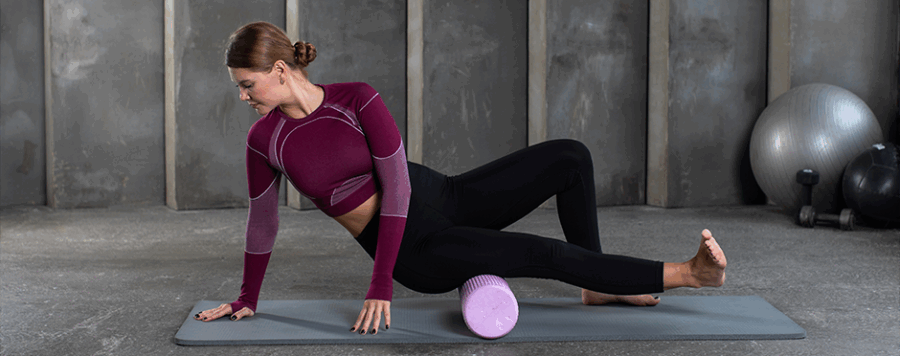External Snapping Hip
Pain on the outer hip is often caused by iliotibial band (IT band) rolling overhead of the femur. This can be from tensor fascia latae tightness and/or muscle imbalances and is often seen with hip flexion, abduction, extension, or external rotation of the hip.
Internal Snapping Hip
Pain in the front of the hip is often caused by iliopsoas (hip flexor) rolling over the hip bone. This can be from increased quad tightness and is elicited with a combination of hip flexion with abduction and/or external rotation of the hip.
Intra-articular Snapping Hip
Pain deep in hip joint that is not as common as external and internal snapping hip. Intra-articular snapping hip can be caused by general instability or tears in cartilage or ligaments and can feel more like clicking or catching.
Muscle tightness from repetitive hip flexion and extension may cause the tendon to become taut and rub over the bone, leading to a decreased range of motion and weakness. Over time, the tendon can become inflamed or irritated, leading to tendinitis or bursitis, so addressing the issue before irritation occurs is important.
4 Tips to Prevent Snapping Hips
1. Warm-up
Make sure you are properly moving your body (i.e. kicking, leg swings, high knees) before performing high intensity jumps.
2. Stretch
The quad, hamstring, and the psoas are often restricted, either from weakness, increased tone, or both. Focusing on increasing hip mobility and range of motion helps address hip pain. Using a foam roll can help to reduce tension in tight hip and thigh muscles and help reduce soreness after a dance class or gymnastics/cheerleading practice.
3. Strengthen
An imbalance between gluteus maximus activation and tensor fascia latae activation is often noted with a snapping hip. Focus on strengthening the gluteus maximus/medius muscles. Other exercises to try are using a resistance band around your knees during marches to strengthen the hip flexor/psoas muscles and performing straight leg raises. Your core plays an important part in keeping your hips stable as well. Incorporate exercises like planks that will target the core and abdominal muscles.
4. Rest and Modify
Most of the time, it is difficult to completely stop being active. However, it is important to listen to your body and perform “relative rest,” where the painful movement or activity is avoided, but movement and strengthening stay consistent.
Snapping hip syndrome is something that can be prevented and helped independently. Keeping the hips mobile and strong is the key to avoiding discomfort, staying healthy, and continuing your sport.
If you experience aches, pains, or symptoms of snapping hip syndrome, contact your nearest Athletico to connect with a movement expert who can help you get back to activity pain-free. Start by scheduling a free assessment and be seen in-clinic or virtually through our telehealth platform.
*Per federal guidelines, beneficiaries of plans such as Medicare, Medicaid, Tricare, VHA and other federally funded plans are not eligible for free assessments.
The Athletico blog is an educational resource written by Athletico employees. Athletico bloggers are licensed professionals who abide by the code of ethics outlined by their respective professional associations. The content published in blog posts represents the opinion of the individual author based on their expertise and experience. The content provided in this blog is for informational purposes only, does not constitute medical advice and should not be relied on for making personal health decisions.
References:
1. Cheatham, Scott W, et al. “Snapping Hip Syndrome: A Review for the Strength and Conditioning Professional.” LWW, Strength & Conditioning Journal, October 2015. journals.lww.com/nsca-scj/fulltext/2015/10000/snapping_ hip_syndrome__a_review_for_the_strength.13.aspx.
2. Musick, Sierra R. “Snapping Hip Syndrome.” StatPearls [Internet]., U.S. National Library of Medicine, 4 Aug. 2023, www.ncbi.nlm.nih.gov/books/NBK448200/.
3. Nolton, Esther C, and Jatin P Ambegaonkar. “Recognizing and managing snapping hip syndrome in dancers.” Medical Problems of Performing Artists, vol. 33, no. 4, 1 Dec. 2018, pp. 286–291, https://doi.org/10.21091/mppa.2018.4042.
4. Walker, Paul, et al. “Snapping Hip Syndrome: A Comprehensive Update.” Orthopedic Reviews, U.S. National Library of Medicine, 22 June 2021, www.ncbi.nlm.nih.gov/pmc/articles/PMC8567760/.
5. Yen, Yi-Meng, et al. “Understanding and Treating the Snapping Hip.” Sports Medicine and Arthroscopy Review, U.S. National Library of Medicine, Dec. 2015, www.ncbi.nlm.nih.gov/pmc/articles/PMC4961351/.
Cassidy was a physical therapist at Athletico Physical Therapy at the time of this blog.

 width="900"
height="356"
>
width="900"
height="356"
>
